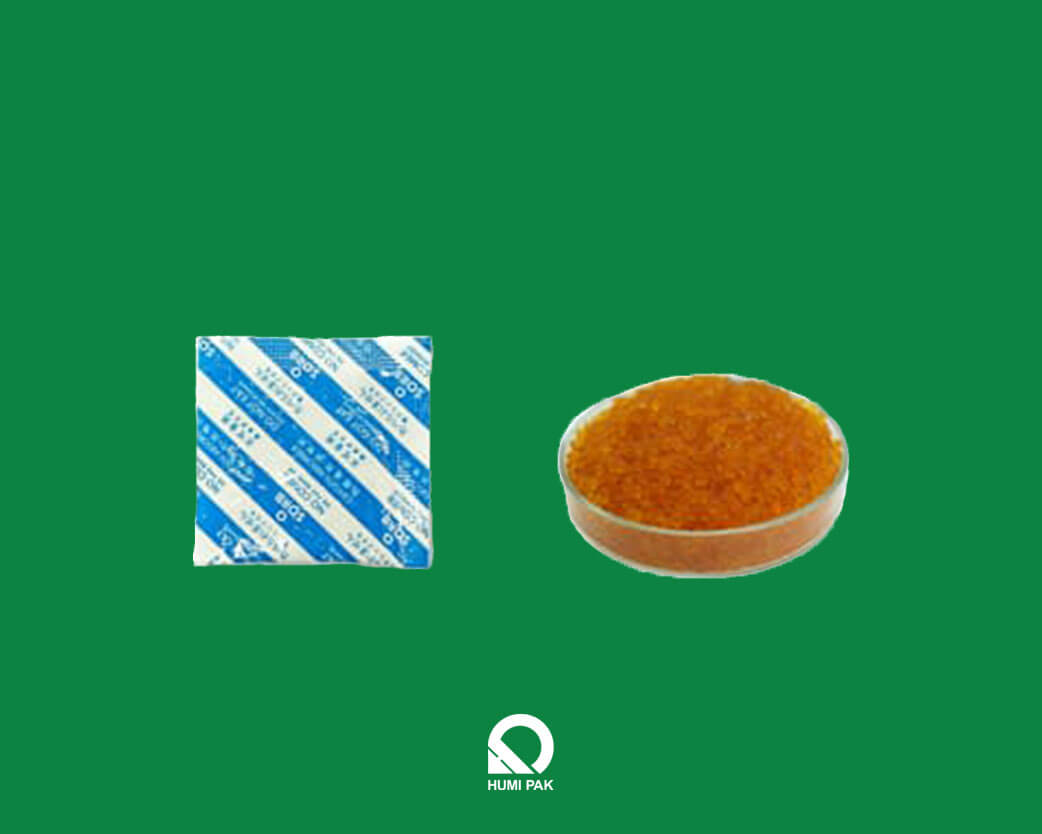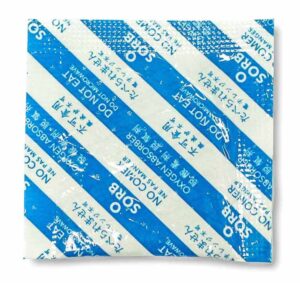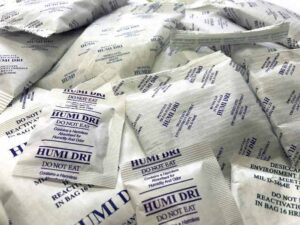Silica Gel vs Oxygen Absorbers

Preserving products, especially food items and sensitive materials, is crucial to maintaining quality, safety, and longevity. Two primary causes that frequently threaten the integrity of these products are moisture and oxygen. Their interaction with different products can lead to various forms of degradation.
Both moisture and oxygen can cause significant challenges in maintaining the quality of products. While they can act independently, their combined presence can often accelerate degradation processes, especially in the case of metallic corrosion. Understanding the role each plays can assist in devising strategies to counteract or minimize their detrimental effects.
What is an Oxygen Absorber?
 Oxygen absorbers are mini sachets containing iron fillings, clay, and salt. The clay element produces moisture, and the combination of salt will activate the iron fillings to absorb oxygen.
Oxygen absorbers are mini sachets containing iron fillings, clay, and salt. The clay element produces moisture, and the combination of salt will activate the iron fillings to absorb oxygen.
This process begins as soon as the oxygen absorber packet is exposed. After exposure, the iron fillings oxidise straightaway, forming rust and releasing nitrogen.
It is this nitrogen that helps in keeping food fresher for a more extended period. The lack of oxygen in the packaging will help keep weevils and insects from infesting the food item.
Most oxygen absorber packets contain a little pink pill that changes colour and turns blue if the oxygen absorber has expired or is no longer useful.
Some other characteristics of oxygen absorbers are:
- Salt and sugar do not need oxygen for long-term storage as both will turn rock solid.
- Once the packaging is exposed, remove what is required and store the rest in an airtight jar.
- Keep the exposure of the oxygen absorbers to a minimum; otherwise, frequent exposure will get them all activated.
- For oxygen absorbers to be effective, use the right amount of oxygen absorbers for the food packaging.
- Oxygen absorbers are not reusable.
Absorbers come in various sizes; determine the quantity required in the container to preserve and store oxygen absorbers measured by cc. O sorb absorbers come in various kinds, from 20 cc to 500 cc. For a five to six-gallon storage bucket, the recommendation would be to use two 500 cc oxygen absorber agents.
Common Uses in Packaging:
- Food Storage: Widely used in packaging perishable foods like dried meats, snacks, and cereals. They help prevent spoilage, maintain flavour, and extend the shelf life.
- Pharmaceuticals: Ensures the potency and efficacy of medicines by preventing oxidation.
- Collectables: Used to preserve the quality of collectable items such as comic books, stamps, and artworks from oxidation and potential aerobic microbial growth.
- Storage of Metal Items: Prevents oxidation or tarnishing of metal components or tools during storage.
- Wine & Spirits: Some premium wine producers use oxygen absorbers in bottle caps to ensure no unwanted wine oxidation occurs.
Mechanism of Action: How Does it Absorb Oxygen?
The primary mechanism for most oxygen absorbers is the oxidation of iron. When the iron powder inside the oxygen absorber is exposed to oxygen, it undergoes a chemical reaction to form iron oxide.
This reaction actively pulls oxygen from the surrounding environment and traps it. The formula for this reaction is 4Fe+3O2→2Fe2O3 This reaction is exothermic, which means it releases heat, but the amount is typically minimal and not usually noticeable to the touch.
Salt acts as a catalyst, speeding up the reaction. Meanwhile, the minimal moisture in the packet is vital, as a small amount of water is necessary for the iron to oxidize. Some oxygen absorbers use other methods, such as ascorbates or reducing agents, but the iron-based mechanism is the most common.
What is Silica Gel?
Silica gel is a highly porous, amorphous form of silicon dioxide, which has gained significant recognition due to its excellent moisture-absorbing capabilities. Often recognized by its bead-like appearance in small packets found in various product packages, silica gel is a desiccant
Silica gel is made from sodium silicate, which undergoes a series of chemical reactions to produce a hard, translucent material. These silica particles are then processed into small beads or granules. The unique structure of silica gel allows it to have large surface areas (around 800 m^2/g), making it excellent for adsorption. The beads can vary in size and are often found in a granular or bead-like form. Some silica gels contain “indicator agents”, which change colour to show when the silica gel has reached its capacity to absorb moisture.
Common Uses in Packaging:
- Food Packaging: To keep food products fresh by controlling humidity levels, which can otherwise lead to mould growth or spoilage.
- Electronics: Used in the packaging of electronics to prevent moisture, which can damage electronic components and lead to short-circuiting.
- Pharmaceuticals: Ensures medicines and drugs remain effective by protecting them from moisture-induced degradation.
- Clothing: Protects garments from moisture, which can cause mould growth or fabric degradation.
- Collectables and Valuables: Used to store items such as jewellery, antiques, and important documents to prevent moisture damage.
- Shipping Containers: Large quantities of silica gel might be used to control the humidity inside shipping containers, especially for sensitive goods.
Mechanism of Action: How Does it Absorb Moisture?
Silica gel works through adsorption (not to be confused with absorption). In adsorption, moisture molecules adhere to the surface of the silica gel beads. The porous nature of the silica gel allows water molecules from the air to enter its internal structure, where they become trapped.
The high-affinity silica drives this process for water molecules. As the water molecules adhere to the silica’s surface, they form a thin film. Over time, as the silica gel beads pull more water from the environment, they can become saturated. Once saturated, the silica gel can no longer effectively adsorb moisture unless it’s regenerated by heating to release the trapped moisture.
On its own, silica gel is not flammable, non-toxic, or chemically unreactive. The absorbers are commonly packed with dry food packaging to absorb humidity that may spoil the food. Reuse the silica gel by heating as it will stave off any prior absorption.
The desiccant can be used for conventional packing and is available in various sizes for different applications. Silica gel can absorb approximately 40 per cent of humidity or oxygen of its weight. The shelf life of silica gel is indefinite if stored in the right conditions. It is also helpful in eliminating odour.
Combining Both for Optimal Preservation
Utilizing both silica gel and oxygen absorbers in packaging can create an environment that mitigates the risks of both moisture and oxygen. By simultaneously addressing these two major factors of product degradation, products can be preserved in their best state for extended periods.
While silica gel and oxygen absorbers offer protection against moisture and oxygen, combining them can offer a comprehensive preservation solution for many products. Proper integration and monitoring ensure that products remain in peak condition for extended durations.
Situations Where Using Both Can Be Beneficial:
- Food Storage: Foods like jerky, dried fruits, and dehydrated meals are sensitive to moisture and oxygen. While moisture can make them spoil or develop mould, oxygen can cause them to become rancid or lose nutritional value.
- Electronics: While most people recognize the dangers of moisture for electronics, oxygen can also cause slow oxidative damage to certain components, particularly in high-end or sensitive devices.
- Pharmaceuticals: Certain medications can degrade when exposed to oxygen, while moisture can affect their composition and efficacy.
- Archival Storage: When storing important documents, photographs, or collectables, moisture and oxygen can accelerate degradation, fading, or other damage.
- Metal Components: While oxygen can cause metals to oxidize or tarnish, moisture can accelerate this process, especially for metals that are also sensitive to corrosion.
Best Practices for Integrating Both into Packaging:
- Appropriate Sizing: Choose silica gel packets and oxygen absorbers based on the volume of the package. Overpacking can be wasteful, and underpacking may not provide sufficient protection.
- Placement: Ensure that both packets are distributed evenly, especially in larger packaging. For instance, if you’re storing bulk food in a large container, place a few packets at the bottom, middle, and top.
- Seal Promptly: Once you add the oxygen absorber, seal the package immediately to ensure it starts working on the air inside the package, not the ambient environment.
- Use Quality Packaging: Use vacuum-sealed or airtight containers to ensure that no external contaminants can penetrate once moisture and oxygen are controlled.
- Monitor & Replace: For long-term storage, periodically check the state of your desiccants and oxygen absorbers. Silica gels with indicator agents can tell you when they’re saturated, and while oxygen absorbers don’t have a visual indicator, a puffy appearance might indicate a compromised packet.
- Avoid Direct Contact: In food packaging, ensure that the product doesn’t directly touch the silica gel or oxygen absorber. While these packets are generally safe, direct contact might not be advisable for consumption.
- Storage: To prolong their lifespan, store unused silica gel packets and oxygen absorbers in a sealed, airtight container.
Conclusion
Both silica gel and oxygen absorbers serve distinct yet complementary roles in product preservation. Silica gel, a moisture combatant, operates through adsorption, safeguarding products from humidity-related issues. On the other hand, oxygen absorbers, typically composed of iron powder, actively remove oxygen from packaging, preventing oxidative damage and the proliferation of aerobic microbes.
The combined use of these tools can offer comprehensive protection, particularly valuable for products sensitive to moisture and oxygen. Humi Pak supplies both silica gel and oxygen absorbers for diverse packaging needs. Our silica gel desiccant bags are manufactured in Malaysia and meet ISO 9001 and 14001 standards. All products undergo stringent quality checks in our QA laboratory. For further details or inquiries, please feel free to contact us.


